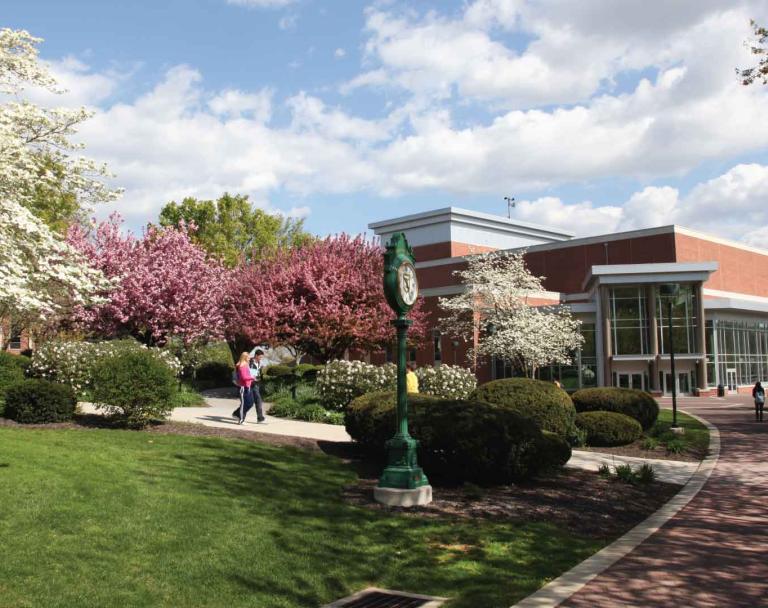Gallery Director Brings Indonesian Art and Artists to York College of Pennsylvania

Gallery Director Brings Indonesian Art and Artists to York College of Pennsylvania
Matthew Clay-Robison, Gallery Director at York College of Pennsylvania, was inspired by a trip to Indonesia in 2018. When COVID-19 forced him to cancel a trip back to the country in 2020, he found a way to bring the culture to York.
Matthew Clay-Robison took his first trip to Indonesia in 2018. While taking a walk with his kids on the campus of Sanata Dharma University in Yogyakarta, he came across a book inside a glass case with a woodcut on the cover. He didn’t understand the language. He didn’t know how to ask if he could look at the book. But, he immediately knew: this is what he’d been looking for.
The trip was organized by George Mason University’s Carter School for Peace and Conflict Resolution. For Clay-Robison, it was an opportunity to scour for ideas on what to bring back to York College of Pennsylvania, where he works as the Gallery Director.
Clay-Robison explains, “I had an idea for an exhibition that would present a century of printmaking that bears witness to the social conditions of the artists’ time and place. Beginning with the work of one of my favorite artists, Käthe Kollwitz, I imagined this as an international lineage of female printmakers.”
Connection through art
In Indonesia, Clay-Robison hoped to find an artist whose work carried on the tradition of Kollwitz. It turns out, that beautiful book cover that caught his eye was created by an artist he would soon meet. “I was at an event and saw the original work that was reproduced on the book cover and couldn’t believe it.” The artist, Fitri DK, invited Clay-Robison to visit her studio and present a guest lecture at her artist collective, Survive!Garage. While there, she also gave him a tour of another artist collective she belongs to, Taring Padi.
Based in Yogyakarta, Indonesia, Taring Padi formed amid the upheaval surrounding the fall of the repressive Suharto New Order regime that took power following the mass killings of 1965-1966. Their work emphasizes the importance of collaboration and making solidarity, denouncing corruption, environmental exploitation, inequality, and neo-imperialism while advocating for the poor and dispossessed, especially farmers whose land is threatened by development projects.
That trip was the start of a newfound fascination with Indonesian art and culture, Clay-Robison says. “Visual art has the power to communicate universal experiences, emotions, and recognized truths for which words fail to express or simply do not exist. In the absence of a common spoken language, visual art may function as a vital agent of intercultural expression and understanding.”
A change of plans
Clay-Robison’s first trip to Indonesia inspired him to return. This time, he planned to do so through a Fulbright Scholarship, which focuses on cultural exchange programs. Clay-Robison got the news he was selected as a Fulbright U.S. Scholar two weeks before the COVID-19 lockdown in 2020.
That wasn’t the only plan that had to be paused. His new friends from Indonesia were to get on a plane to York College on March 12, 2020. That was also canceled.
While his Fulbright trip remains on hold even now, there is a possibility the program will start processing visas again as soon as March 2022.
And despite his artist friends not being able to visit two years ago, three of them, Fitri DK, Bayu Widodo, and Mohamed “Ucup” Yusuf, arrived in York on Oct. 13, 2021, for a month-long residency as part of a special exhibit called Solidaritas tanpa Batas (Solidarity without Boundaries), hosted on campus and at Marketview Arts showcasing the work of Taring Padi. This was actually the second exhibition of fall 2021 to feature Indonesian artists, the first being Entang Wiharso’s exhibition, A Thousand Kilometers which was reviewed in one of Indonesia’s largest newspapers, Kompas, and also featured in Art Asia Pacific Magazine.
Through his experience of working with artists from around the world, Clay-Robison is most interested in learning what connects people. “While our communities, homes, and cultural practices are different, there are many commonalities that help us understand one another,” he says. “That’s what I want to dig into.”

